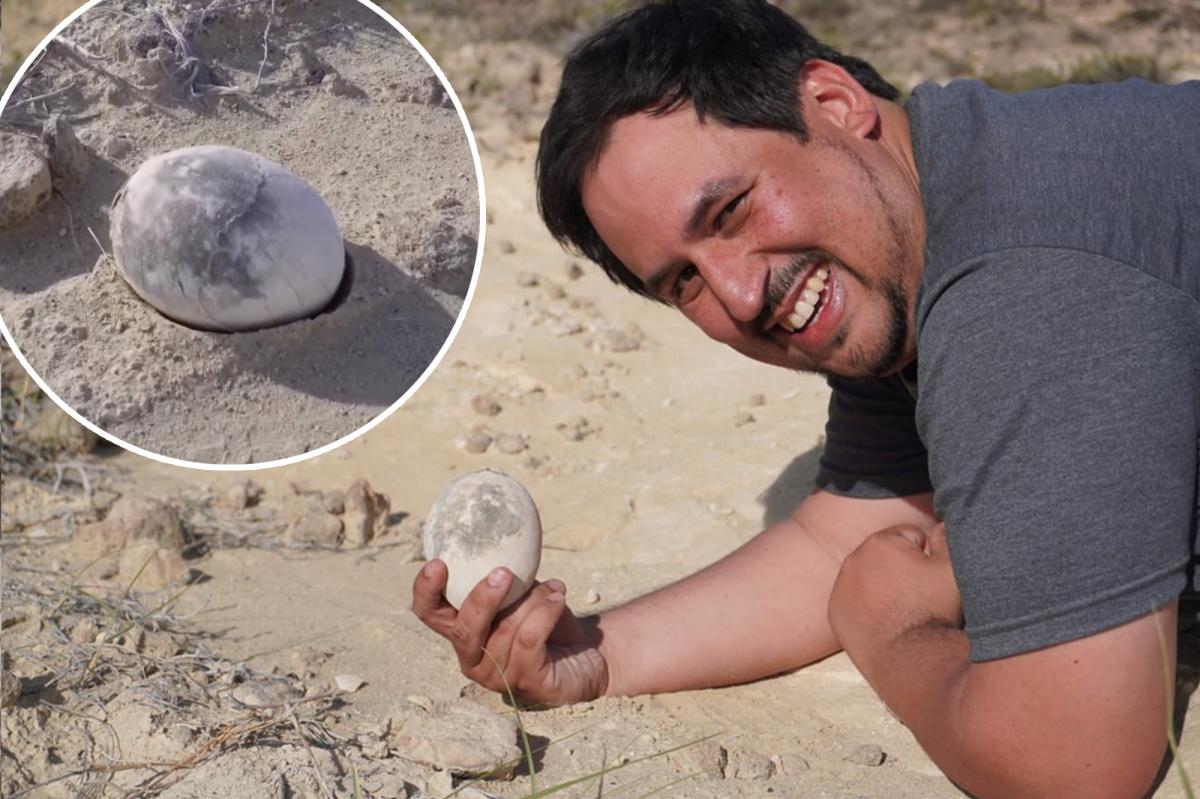It was in egg-cellent condition.
Argentine paleontologists found a real diamond in the rough after happening across a perfectly preserved 70-million-year-old dinosaur egg during an excavation.
“It was a complete and utter surprise,” Gonzalo Leonel Muñoz, a Vertebrate paleontologist at the Bernardo Rivadavia Argentine Museum of Natural Sciences, told National Geographic of the “spectacular” find. “‘It’s not uncommon to find dinosaur fossils, but the issue with eggs is that they are much less common.”
Argentine paleontologists found a real diamond in the rough after happening across a perfectly-preserved 70-million-year-old dinosaur egg during an excavation. @paleocueva.lacev/Instagram
“It’s unusual to find the egg of a possible carnivorous dinosaur, much less in this state,” said Muñoz while describing the egg (pictured). @paleocueva.lacev/Instagram
The team of paleontologists was reportedly conducting an excavation campaign in the fossil-rich region of Río Negro, when they stumbled across the primeval embryo.
While dinosaur eggs had been excavated in the area before, finding one this well-preserved was super rare.
Accompanying footage and photos posted to the Laboratory of Comparative Anatomy and Vertebrate Evolution’s (LACEV) Instagram page show team leader and world-class anatomist Federico Agnolín handling the egg, which is in such immaculate condition that it looks hard-boiled.
“This is quite possibly the FIRST finding of this guy in South America,” reads the caption to one of the clips. “As you can see, this fossil is over 70,000,000 years old, and HE WASN’T ALONE, WE FOUND A NEST.”
Team leader and world-class anatomist Federico Agnolín is handling the egg, which is in such immaculate condition it looks hard-boiled. @paleocueva.lacev/Instagram
This egg, which is about the size of an ostrich embryo, likely belonged to the Bonapartenykus genus – a small, carnivorous theropod that roamed the region during the late Cretaceous period.
“It’s unusual to find the egg of a possible carnivorous dinosaur, much less in this state,” said Muñoz, noting that they were used to seeing “sauropod dinosaur eggs (those with long necks), but these had spherical eggs, like enormous balls, with thicker shells.”
An artist’s depiction of a Bonapartenykus – a small, carnivorous theropod that roamed the region during the late Cretaceous period. TotalDino
The scientist observed that finding the eggs of carnivorous dinosaurs was rare, as there were far fewer meat-eaters and their eggs were much more fragile, given that they were the ancestors of birds.
“Their eggs are more avian-like, since the carnivorous dinosaur lineage is the one that will give rise to birds,” the dino expert explained. “Therefore, they’re going to be more delicate eggs, with much thinner shells, more prone to destruction.”
The egg, along with other discoveries from the repository, will be sent to the Argentine Museum of Natural Sciences to be examined.
It’s yet unclear whether fossilized shell harbors an embryo — the team will have to conduct in-depth scans to see.
Muñoz hopes that the egg has something inside, as this would confirm what species of dinosaur it is and potentially shed light on dinosaur evolution.
“If it’s a carnivorous dinosaur, it would teach us, for example, how dinosaur eggs evolved into birds,” he said. “It could show us what their chicks were like, what state they were in at birth, whether they’re fully developed or not… Any information it provides will be novel and incredibly interesting.”
No word as to whether scientists could extract the DNA and Frankenstein a hybrid dinosaur a la “Jurassic Park.” The Post has reached out to researchers for further comment.
